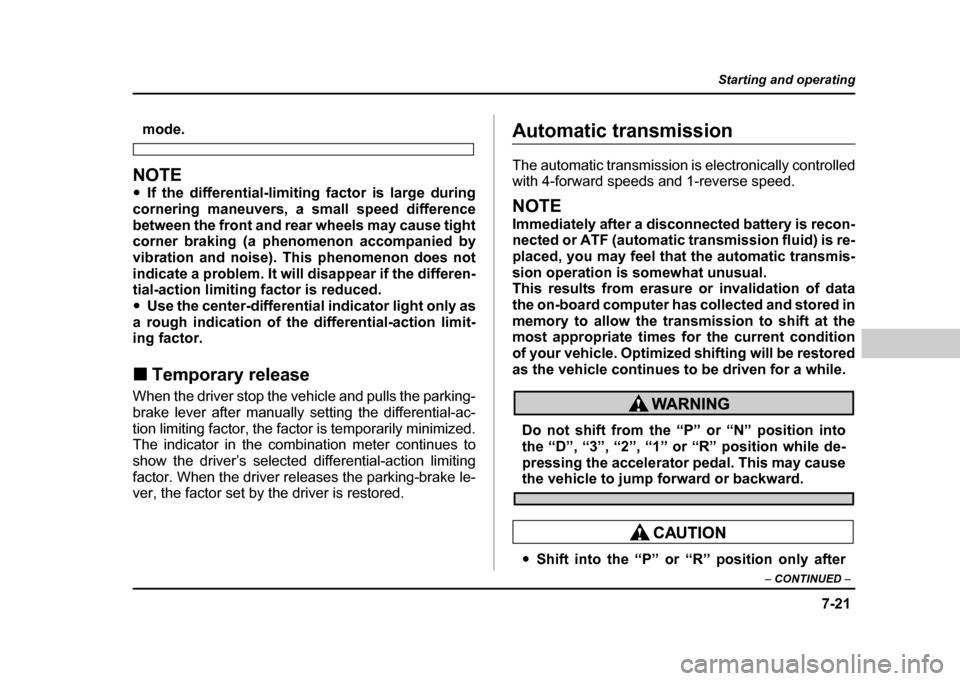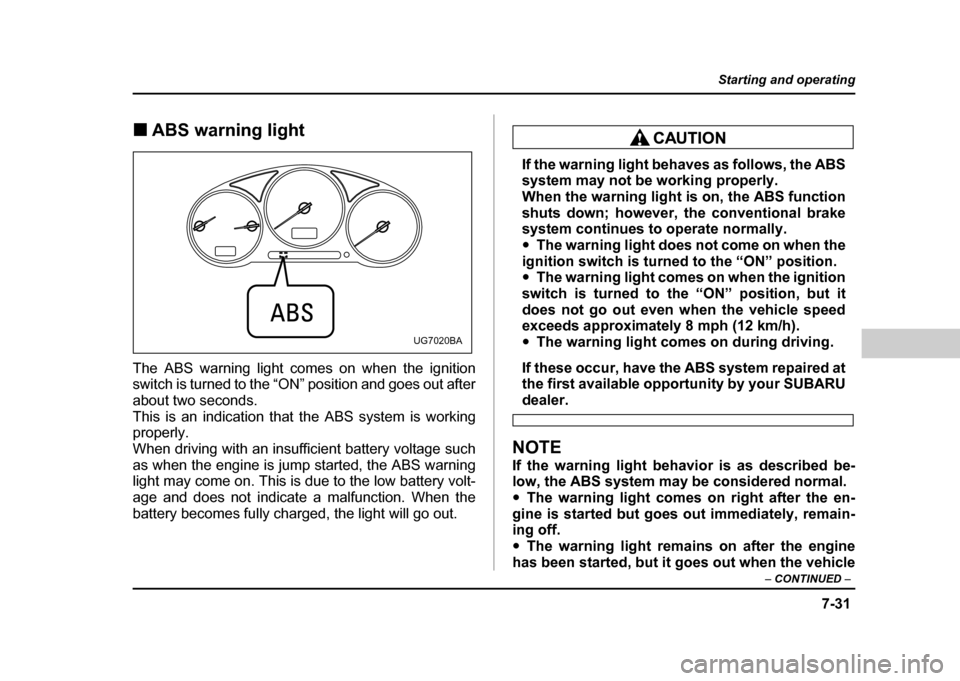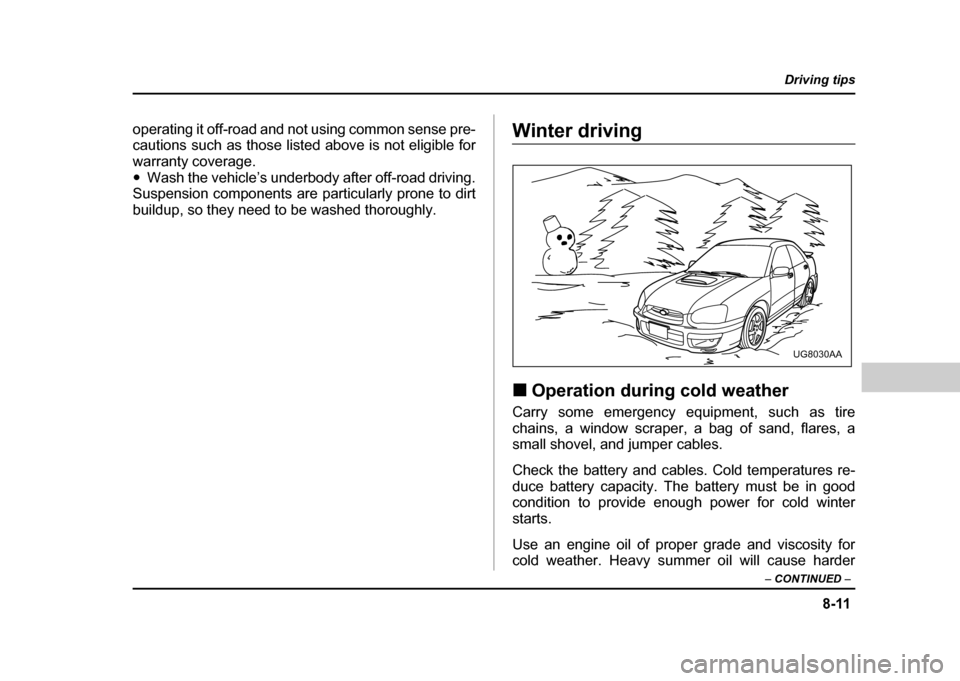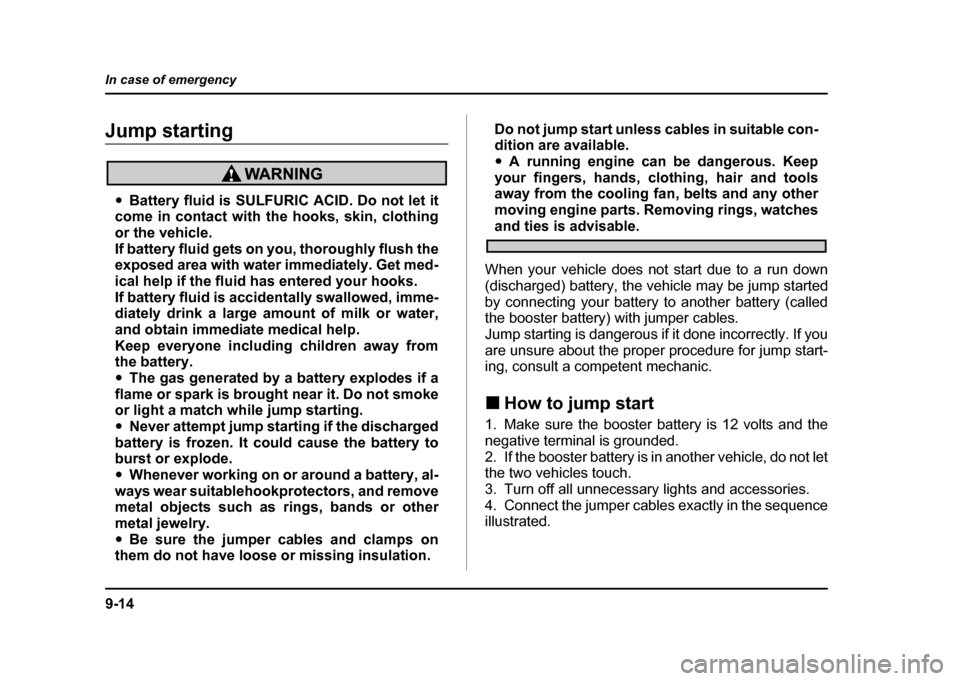2004 SUBARU IMPREZA WRX jump start
[x] Cancel search: jump startPage 161 of 491

3-24
Instruments and controls
as when the engine is jump started, the ABS warning
light may come on. This is due to the low battery volt-
age and does not indicate a malfunction. When the
battery becomes fully charged, the light will go out. !
Brake system warning light
"Driving with the brake system warning light
on is dangerous. This indicates your brake sys-
tem may not be working properly. If the light re-
mains on, have the brakes inspected by a
SUBARU dealer immediately." If at all in doubt about whether the brakes are
operating properly, do not drive the vehicle.
Have your vehicle towed to the nearest
SUBARU dealer for repair.
This light has the following two functions: ! Parking brake warning
The light comes on with the parking brake applied
while the ignition switch is in the “ON” position. It goes
out when the parking brake is fully released. !
Brake fluid level warning
This light comes on when the brake fluid level has
dropped to near the “MIN” level of the brake fluid res-
ervoir with the ignition switch in the “ON” position and
with the parking brake fully released.
If the brake system warning light should come on while
driving (with the parking brake fully released and with
the ignition switch positioned in “ON”), it could be an
indication of leaking of brake fluid or worn brake pads.
If this occurs, immediately stop the vehicle at the near-
est safe place and check the brake fluid level. If the flu-
id level is below the “MIN” mark in the reservoir, do not
drive the vehicle. Have the vehicle towed to the near-
est SUBARU dealer for repair. ! Electronic Brake Force Distribution (EBD) sys-
tem warning (for vehicles with ABS)
The brake system warning light also illuminates if a
malfunction occurs in the EBD system. In that event, it
comes on together with the ABS warning light.
The EBD system may be malfunctioning if the brake
system warning light and ABS warning light illuminate
simultaneously during driving.
Even if the EBD system fails, the conventional braking
system will still function. However, the rear wheels will
be more prone to locking when the brakes are applied
harder than usual and the vehicle’s motion may there-
(U.S.) (Canada)
Page 290 of 491

7-21
Starting and operating
– CONTINUED –
mode.
NOTE "If the differential-limiting factor is large during
cornering maneuvers, a small speed difference
between the front and rear wheels may cause tight
corner braking (a phenomenon accompanied by
vibration and noise). This phenomenon does not
indicate a problem. It will disappear if the differen-
tial-action limiting factor is reduced. " Use the center-differential indicator light only as
a rough indication of the differential-action limit-
ing factor. ! Temporary release
When the driver stop the vehicle and pulls the parking-
brake lever after manually setting the differential-ac-
tion limiting factor, the factor is temporarily minimized.
The indicator in the combination meter continues to
show the driver’s selected differential-action limiting
factor. When the driver releases the parking-brake le-
ver, the factor set by the driver is restored.
Automatic transmission
The automatic transmission is electronically controlled
with 4-forward speeds and 1-reverse speed.
NOTE
Immediately after a disconnected battery is recon-
nected or ATF (automatic transmission fluid) is re-
placed, you may feel that the automatic transmis-
sion operation is somewhat unusual.
This results from erasure or invalidation of data
the on-board computer has collected and stored in
memory to allow the transmission to shift at the
most appropriate times for the current condition
of your vehicle. Optimized shifting will be restored
as the vehicle continues to be driven for a while.
Do not shift from the “P” or “N” position into
the “D”, “3”, “2”, “1” or “R” position while de-
pressing the accelerator pedal. This may cause
the vehicle to jump forward or backward.
" Shift into the “P” or “R” position only after
Page 300 of 491

7-31
Starting and operating
– CONTINUED –
!ABS warning light
The ABS warning light comes on when the ignition
switch is turned to the “ON” position and goes out after
about two seconds.
This is an indication that the ABS system is working
properly.
When driving with an insufficient battery voltage such
as when the engine is jump started, the ABS warning
light may come on. This is due to the low battery volt-
age and does not indicate a malfunction. When the
battery becomes fully charged, the light will go out.
If the warning light behaves as follows, the ABS
system may not be working properly.
When the warning light is on, the ABS function
shuts down; however, the conventional brake
system continues to operate normally. " The warning light does not come on when the
ignition switch is turned to the “ON” position. " The warning light comes on when the ignition
switch is turned to the “ON” position, but it
does not go out even when the vehicle speed
exceeds approximately 8 mph (12 km/h). " The warning light comes on during driving.
If these occur, have the ABS system repaired at
the first available opportunity by your SUBARU
dealer.
NOTE
If the warning light behavior is as described be-
low, the ABS system may be considered normal." The warning light comes on right after the en-
gine is started but goes out immediately, remain-
ing off." The warning light remains on after the engine
has been started, but it goes out when the vehicle
UG7020BA
Page 322 of 491

8-11
Driving tips
– CONTINUED –
operating it off-road and not using common sense pre-
cautions such as those listed above is not eligible for
warranty coverage."Wash the vehicle’s underbody after off-road driving.
Suspension components are particularly prone to dirt
buildup, so they need to be washed thoroughly.Winter driving ! Operation during cold weather
Carry some emergency equipment, such as tire
chains, a window scraper, a bag of sand, flares, a
small shovel, and jumper cables.
Check the battery and cables. Cold temperatures re-
duce battery capacity. The battery must be in good
condition to provide enough power for cold winter starts.
Use an engine oil of proper grade and viscosity for
cold weather. Heavy summer oil will cause harder
UG8030AA
Page 352 of 491

9-1
9
In case of emergency
If you park your vehicle in case of an emergency ............................................ 9-2
Temporary spare tire .................................... 9-3
Flat tires ......................................................... 9-5 Changing a flat tire ........................................... 9-5
Jump starting ................................................ 9-14 How to jump start ............................................. 9-14
Engine overheating ....................................... 9-16 If steam is coming from the engine compartment .................................................. 9-16
If no steam is coming from the engine compartment .................................................. 9-16
Towing ........................................................... 9-17 Towing and tie-down hooks ............................ 9-18
Using a flat-bed truck ....................................... 9-20
Towing with all wheels on the ground ............ 9-21
Rear gate – if the rear gate cannot be unlocked ..................................................... 9-22
Moonroof – if the moonroof cannot be closed ......................................................... 9-23
Maintenance tools ......................................... 9-24 Jack and jack handle ........................................ 9-24
Page 365 of 491

9-14
In case of emergency
Jump starting
"
Battery fluid is SULFURIC ACID. Do not let it
come in contact with the hooks, skin, clothing
or the vehicle.
If battery fluid gets on you, thoroughly flush the
exposed area with water immediately. Get med-
ical help if the fluid has entered your hooks.
If battery fluid is accidentally swallowed, imme-
diately drink a large amount of milk or water,
and obtain immediate medical help.
Keep everyone including children away from the battery. " The gas generated by a battery explodes if a
flame or spark is brought near it. Do not smoke
or light a match while jump starting. " Never attempt jump starting if the discharged
battery is frozen. It could cause the battery to
burst or explode. " Whenever working on or around a battery, al-
ways wear suitablehookprotectors, and remove
metal objects such as rings, bands or other
metal jewelry. " Be sure the jumper cables and clamps on
them do not have loose or missing insulation. Do not jump start unless cables in suitable con-
dition are available. "
A running engine can be dangerous. Keep
your fingers, hands, clothing, hair and tools
away from the cooling fan, belts and any other
moving engine parts. Removing rings, watches
and ties is advisable.
When your vehicle does not start due to a run down
(discharged) battery, the vehicle may be jump started
by connecting your battery to another battery (called
the booster battery) with jumper cables.
Jump starting is dangerous if it done incorrectly. If you
are unsure about the proper procedure for jump start-
ing, consult a competent mechanic. ! How to jump start
1. Make sure the booster battery is 12 volts and the
negative terminal is grounded.
2. If the booster battery is in another vehicle, do not let
the two vehicles touch.
3. Turn off all unnecessary lights and accessories.
4. Connect the jumper cables exactly in the sequence
illustrated.
Page 481 of 491

14-2
Index
A
ABS (Anti-lock Brake System)
...............................7-30
Warning light ................................................. 3-23, 7-31
Accessories ......................................................... 5-3, 11-63
Accessory power outlet ...................................6-9, 6-11
Active head restraint .................................................. 1-6
Air cleaner element ..................................................... 11-23
Air conditioner operation ..........................................4-9
Air filtration system ..................................................... 4-20
Air flow selection .......................................................... 4-2
Aluminum wheels ........................................................ 11-53
Ambient temperature gauge .........................3-11, 3-18
Antenna system ........................................................... 5-2
Anti-lock Brake System (ABS) ...............................7-30
Arming the system ...................................................... 2-15
Armrest ............................................................................ 1-9
Ashtray ............................................................................. 6-12
AT OIL TEMPerature warning light ......................3-22
Audio set ......................................................................... 5-3
Auto-dimming mirror /compass .............................3-44
Automatic/Emergency Locking Retractor (A/ELR) ....................................................................... 1-15
Automatic transmission ............................................. 7-21
Capacities ................................................................. 12-4
Fluid ............................................................................ 11-31
Selector lever .......................................................... 7-22
Shift lock release ................................................... 7-26Temperature warning light
.................................3-22
BBattery ............................................................................... 11-58
Jump starting ........................................................... 9-14
Replacement (Remote keyless entry system) .................................................................... 2-9
Brake Booster ....................................................................... 11-40
Fluid ............................................................................. 11-37
Pad and lining .......................................................... 11-42
Pedal ........................................................................... 11-40
Brake system ................................................................. 7-29
Warning light ............................................................ 3-24
Braking .............................................................................. 7-28
Breaking-in of new brake pads and linings .11-43
Tips .............................................................................. 7-28
Brake pedal
Free play .................................................................... 11-40
Reserve distance ................................................... 11-41
Bulb
Chart ............................................................................ 12-9
Replacing ................................................................... 11-64
C
Capacities ........................................................................ 12-4
Page 484 of 491

14-5
Index
Seatbelt pretensioners
.......................................1-27
Seats ........................................................................... 1-2
Turn signal light and parking light ...................11-70
Front-wheel drive warning light ..............................3-25
Fuel .................................................................................... 7-2
Economy hints ........................................................ 8-2
Filler lid and cap ..................................................... 7-4
Gauge .................................................................. 3-9, 3-16
Requirements .......................................................... 7-2
Fuses ................................................................................ 11-60
Fuses and circuits ....................................................... 12-6
G
GAWR (Gross Axle Weight Rating) .....................8-20
Glove box ........................................................................ 6-6
GVWR (Gross Vehicle Weight Rating ) .............8-20
H
Hazard warning flasher ............................................. 3-6
Headlight beam leveler ............................................. 3-33
Headlight indicator light ............................................3-27
Headlights ......................................................... 3-29, 11-66
Headrest adjustment (Wagon) ..............................1-11
Head restraint adjustment (Front) .......................1-5
Heater operation .......................................................... 4-6
High beam indicator light ..........................................3-26
High mount stop light ................................................. 11-78Horn
.. .. ... .. ... ... .. ... .. ... ... .. ... ... .. ... .. ... ... .. ... ... .. ... .. ... ... .. ... ... .. .. 3-5 0
Hose and connections ............................................... 11-19
I
Ignition switch ............................................................... 3-3
Illuminated entry ........................................................... 2-8
Illumination brightness control ...............................3-32
Indicator light High beam ................................................................ 3-26
Selector lever position ......................................... 3-26
Turn signal ............................................................... 3-26
Inside mirror ................................................................... 3-44
Intercooler water spray ............................................. 11-53
Warning light ........................................................... 3-25
Switch ........................................................................ 3-43
Internal trunk lid release handle ............................2-26
J
Jack and jack handle ................................................. 9-24
Jump starting ................................................................. 9-14
KKey Interlock release .................................................... 3-5
Number ...................................................................... 2-3
Reminder chime ..................................................... 3-4